25 Stunning Examples of Pyramid Across The World (+ Pics)

Pyramids are monumental structures built roughly in the shape of geometrical pyramids: the outer surfaces are triangular, and they converge to a single step at the top. The pyramid’s base can be trilateral, quadrilateral, or any polygon shape.
The square pyramid—having four outer triangular surfaces over a square base—is one of the most common types. Due to the structure of the pyramid, the majority of the weight is closer to the ground. This helped early civilizations create stable monumental structures, which is why pyramids existed worldwide.
Pyramids were usually built as tombs for kings and nobles. Various cultures, such as the Mesopotamians, also used them as temples. In Mexico, pyramids were also a place of human sacrifice. In our world, modern architects still create pyramid-like structures, such as the Louvre.
Read: Pyramid of Numbers: Definition, Types and Examples
Let us look at 25 most popular examples of pyramids:
25 Spectacular Examples of Pyramid
1. The Great Pyramid of Giza

This is the largest Egyptian pyramid and one of the largest in the world too. It served as the tomb of Pharaoh Khufu, who ruled under the Fourth Dynasty of the Old Kingdom. The pyramid was built in the early 26th century, making it the oldest of the Seven Wonders of the Ancient World and also the only one that remains largely intact.
The pyramid was initially 146.6 meters (481 feet) tall and was the tallest man-made structure for about 3,800 years. Over time, however, its smooth white limestone casing got weathered, and it is now about 138.5 meters (454.4 ft) in height.
It was built over 27 years with 2.3 million large blocks; these stones are not uniform in size/shape but are bound together by mortar. Primarily local limestone from the Giza plateau was used for the construction.
2. Ziggurat

Ziggurats, built by the Mesopotamians in the 6th century BC, were the precursors to the pyramids of Egypt. These were pyramidal structures with flat tops, built as receding tiers upon a rectangular, oval, or square platform. Ziggurats were brightly painted in gold/bronze, but they were made up of sun-dried mud-brick, so they could not stand the test of time.
Many civilizations—such as the Sumerians, Babylonians, and Elamites—built these for their local religions, and each ziggurat was part of a temple complex. The outside bricks were believed to have astrological significance, and kinds often had their names engraved on them. The access to the shrine would have been through a series of ramps on one side of the structure or by a spiral ramp from the base to the top.
3. Step-Pyramid
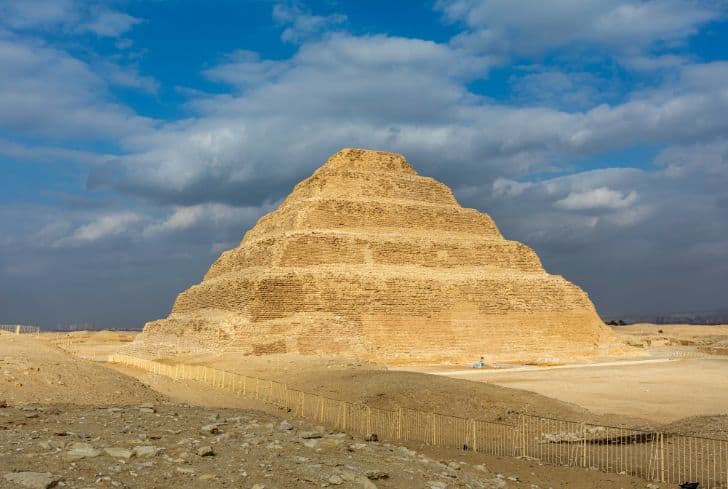
A step pyramid uses flat platforms or steps, receding from the ground up, to create a pyramid-like shape. The ancient Egyptians built pyramids from 2700 BC until around 1700 BC, and the step pyramid was one of their first types. Step pyramids have been built by several cultures throughout the world, although there are no firmly established connections between them.
In Egypt, the first one was erected by the Pharaoh Djoser and his architect Imhotep, during the Third Dynasty. This step pyramid had six stacked mastabas (tombs). Ahmose was the last king to build royal pyramids, after which kings hid their tombs in hills. All Egyptian pyramids were placed west of the river Nile because of the belief that the pharaoh’s soul would join the sun during its descent.
4. Chichen Itza

Chichen Itza is an ancient Mayan city located in the Yucatan Peninsula of Mexico. It was one of the largest and most important Mayan cities, and is now a UNESCO World Heritage site and one of the most popular tourist destinations in Mexico.
The city was founded in the 6th century CE and reached its peak in the 10th century CE. It was a center of political, economic, and religious activity, and was home to a large population of Mayan people.
The most famous structures at Chichen Itza are the El Castillo pyramid and the Temple of the Warriors. El Castillo is a massive pyramid that stands over 98 feet (30 meters) tall and features a series of terraces and staircases leading to a temple at the top. The Temple of the Warriors is another impressive structure, featuring a large plaza surrounded by columns and statues.
5. Tomb of Askia
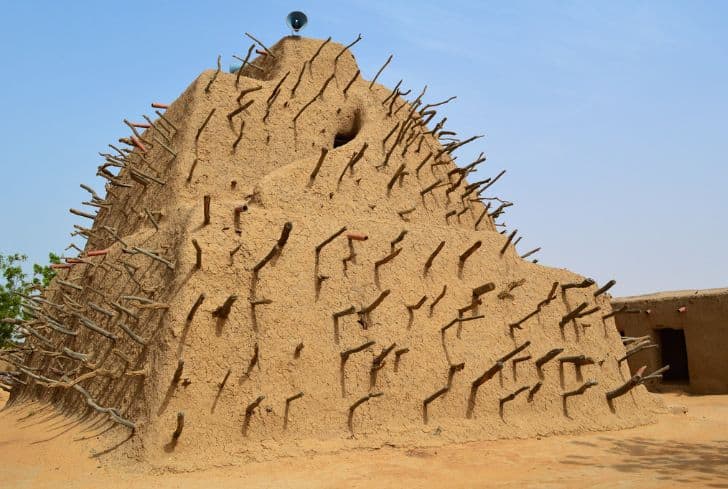
The Tomb of Askia (emperor of Songhai) is an example of the monumental mud constructions of the Sahel. It is part of an architectural complex making the Mausoleum of the Emperor, which includes two mosques and a cemetery. It is made up of mud and covered with several wooden pikes.
Emperor Askia built it after his pilgrimage to Mecca in the 15th century. The monument survived jihadist attacks during the Mali War and remains as the last tomb pyramid by an African sovereign.
6. Nubian Pyramids

Nubian pyramids are a type of pyramid structure built by the ancient Nubian civilization, located in what is now modern-day Sudan. These pyramids were constructed between 800 BCE and 350 CE, during the height of the Nubian civilization.
Unlike the more famous pyramids of Egypt, which are known for their massive size and grandeur, Nubian pyramids are smaller and more modest in design. They were typically built from mud brick and then covered in a layer of white plaster, giving them a distinctive appearance.
Nubian pyramids were used as tombs for the rulers and elite members of Nubian society. The tombs were often adorned with intricate carvings and paintings, depicting scenes from the life of the deceased and their journey into the afterlife.
Today, many of the Nubian pyramids have been damaged or destroyed due to looting and natural erosion. However, efforts are being made to preserve and restore these ancient structures, which provide valuable insight into the history and culture of the Nubian civilization.
7. Pyramid of Hellenikon
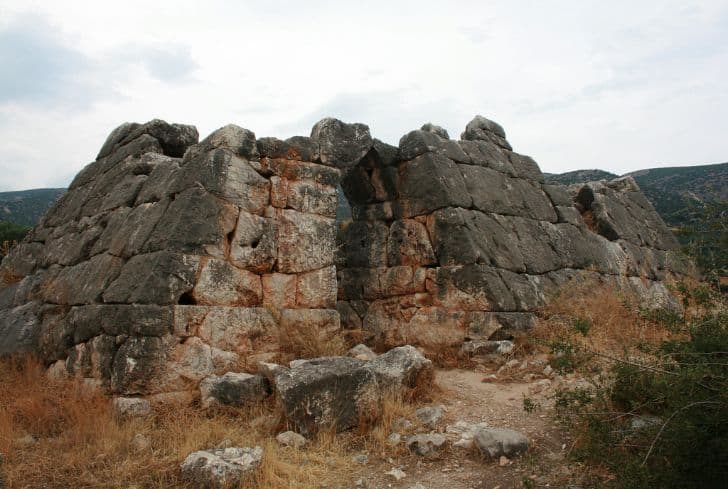
The Pyramid of Hellenikon is one of Greece’s two surviving pyramid-like structures, the other being at Ligourio/Ligurio. These monuments do have inwardly sloping walls, but other than that, there is no obvious resemblance to Egyptian pyramids. Unlike the Egyptian ones, these pyramids have large central rooms, and the Hellenikon monument is rectangular (not square).
Its dimensions are 12.5 by 14 meters, so its sides could not have met at a point. Moreover, these structures were made using limestone, which was quarried locally and cut to fit; this is in contrast to the freestanding blocks like the ones used in the Great Pyramid of Giza. Pot shards excavated from the floor and the grounds have helped to date these structures: they probably existed around the 5th and 4th centuries.
8. Pyramids of Güímar
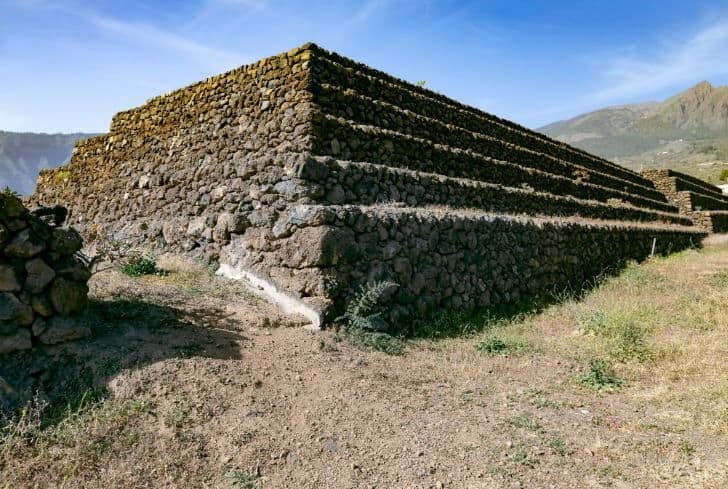
The Pyramids of Güímar are six rectangular pyramid-shaped, terraced structures, located in the district of Chacona (part of the two of Güímar on the island of Tenerife). These are built from lava stone without the use of mortar.
The Pyramids of Güímar are dated to the 19th century, and scholars have explained their original function as a byproduct of contemporary agricultural techniques. Guanche traditions and surviving images indicate that similar structures might have existed in many locations around the island. Unfortunately, over time, they were dismantled and used as cheap building materials. Out of 9, only six pyramids now remain.
9. Mesoamerican Pyramids (Great Pyramid of Cholula)
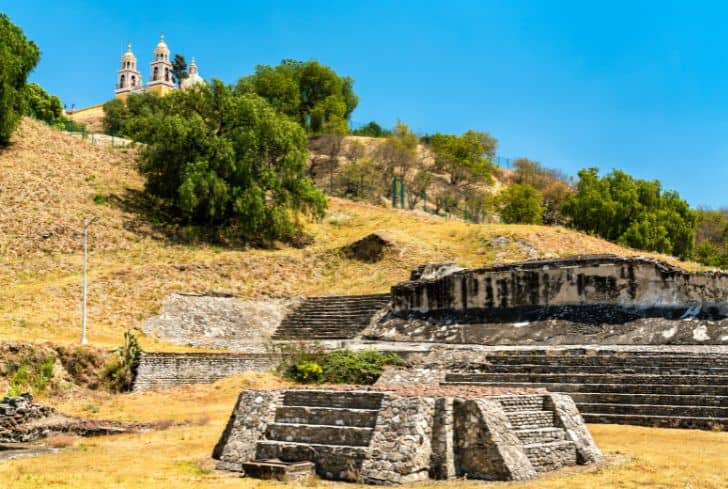
The Mesoamerican pyramids were usually stepped, having temples on the top; as such, they were more similar to the Mesopotamian ziggurats than Egyptian pyramids. Among these is the Great Pyramid of Cholula, which is the largest pyramid by volume known to exist in the world.
It is a complex located in Cholula, Puebla, Mexico, and it is known as Tlachihualtepetl (meaning “made-by-hand mountain”). The pyramid is a temple and has traditionally been viewed as being dedicated to the god Quetzalcoatl. Its architectural style is linked closely to that of Teotihuacan, but the influence from the Gulf Coast is also visible
Another huge pyramid, the Pyramid of the Sun, is also located in Mexico (Teotihuacan). Finally, an unusual pyramid with a circular plan exists in Cuicuilco (now in Mexico City). It is mostly covered with lava from an eruption of the Xilte Volcano in the 1st century BC. Pyramids in Mexico were often used as places of human sacrifice. Michale Harner suggests that over 20,000 humans may have been sacrificed there.
10. The Louvre Pyramid (Paris)
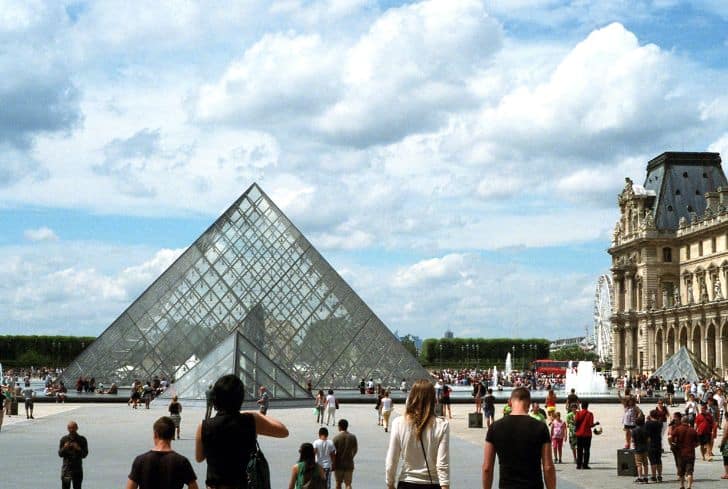
The Louvre Pyramid is one of the many modern pyramid-shaped structures that are built all over the world. This large pyramid serves as the main entrance to the Louvre Museum (the world’s largest museum). It is built in the main courtyard of the Louvre Palace and is surrounded by three smaller pyramids.
Pyramide du Louvre is a large glass and metal structure that was designed by the Chinese-American architect I.M. Pei. It is about 20.6 meters or 70 feet in height, and it was completed in 1989. The Pyramide Inversée (Inverted Pyramid) is also visible in the underground Louver shopping mall. Ever since its construction, the Louvre Pyramid has become a landmark of the city.
There are many other examples of modern pyramid-like structures. For example, the Luxor Hotel in Las Vegas (the United States) is a 30-story structure with a light beaming at the top. The Pyramid Arena in Memphis, Tennessee is another marvellous structure, which was the home court for the NBA’s Memphis Grizzlies until 2004.
11. Pyramid of Cestius

The Pyramid of Cestius is an ancient pyramid located in Rome, Italy. It was built around 18-12 BC as a tomb for Gaius Cestius, a magistrate and member of one of Rome’s most prestigious families.
The pyramid is made of white marble and stands about 120 feet tall. It has a square base with sides measuring 98 feet and is aligned with the cardinal points. The pyramid was originally covered in white stucco, but much of it has worn away over time.
The pyramid’s interior contains a single burial chamber, accessed through a narrow passageway leading to a small antechamber. The walls of the burial chamber are decorated with frescoes depicting scenes from the deceased’s life.
The pyramid was incorporated into the Aurelian Walls, which were built in the 3rd century AD. The pyramid became a popular landmark in Rome and was mentioned in many works of literature, including works by the poet Shelley and the writer Goethe.
In the 17th century, the pyramid was restored and a new inscription was added to the base. The inscription reads “CAIVS CESTIVS EPVLONVM” and indicates that the pyramid was built as a tomb for Gaius Cestius.
Today, the Pyramid of Cestius is a popular tourist attraction and is open to the public on certain days. It is one of the best-preserved ancient pyramids in the world and is a fascinating example of ancient Roman architecture.
12. Monks Mounds

Monks Mound is the largest prehistoric earthwork in North America and is located at Cahokia Mounds State Historic Site in Illinois, USA. It was constructed by the Mississippian culture around 900-1200 AD. The mound is named after the Trappist monks who lived nearby in the 19th century.
The mound is a massive earthen structure, measuring approximately 100 feet in height and covering an area of 14 acres at its base. It was built in several stages using baskets and hand tools to move soil from nearby areas. The mound was likely used for ceremonial and religious purposes, as well as for the residences of the elite.
The summit of the mound is flat and measures about 200 feet by 500 feet. It was likely used as a platform for important ceremonies and rituals. The mound was also the center of a large city that covered over six square miles and was home to tens of thousands of people.
Today, Monks Mound is a popular tourist attraction and a UNESCO World Heritage Site. Visitors can climb to the top of the mound and enjoy a panoramic view of the surrounding area. The site also features a museum and interpretive center that provides information about the history and culture of the Mississippian people who built the mound.
13. Pyramids of Teotihuacan
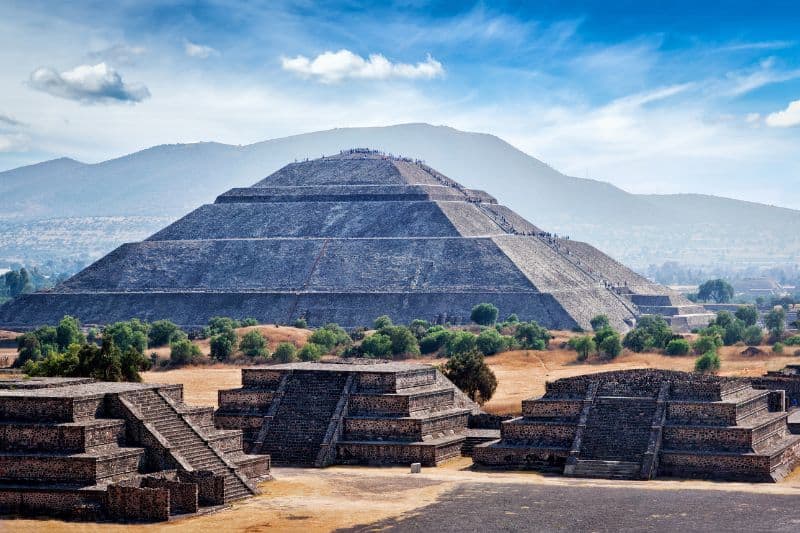
The Pyramids of Teotihuacan are a complex of ancient Mesoamerican pyramids located in the Basin of Mexico, about 30 miles (50 km) northeast of modern-day Mexico City. The site was designated a UNESCO World Heritage Site in 1987.
The most famous structures at Teotihuacan are the Pyramid of the Sun and the Pyramid of the Moon, which were built between 100 BCE and 250 CE. The Pyramid of the Sun is the largest structure at Teotihuacan, standing at over 200 feet (60 meters) tall. The Pyramid of the Moon is slightly smaller, but still an impressive structure, standing at over 140 feet (43 meters) tall.
The Teotihuacan civilization built the pyramids, which flourished between 200 BCE and 650 CE. The civilization was one of the largest and most influential in the pre-Columbian Americas, with an estimated population of around 100,000 people at its peak.
14. Ranganathaswamy Temple. India

The Ranganathaswamy Temple is a Hindu temple located in the city of Srirangam, Tamil Nadu, India. It is one of the most important and largest temples in India, and is dedicated to Lord Ranganatha, a form of Lord Vishnu.
The Ranganathaswamy Temple is believed to have been built in the 10th century AD, and has been expanded and renovated over the centuries. The temple complex covers an area of over 156 acres and is surrounded by seven walls, with 21 gopurams (tower gateways) that are adorned with intricate carvings and sculptures.
The main shrine of the Ranganathaswamy Temple is located in the innermost enclosure, surrounded by a large hall supported by 1,000 pillars. The hall is known as the “Thousand Pillar Hall” and is considered one of the architectural marvels of India.
The Ranganathaswamy Temple is also home to several smaller shrines and sanctums that are dedicated to various gods and goddesses. The temple is known for its beautiful carvings, sculptures, and paintings depicting scenes from Hindu mythology and history.
15. Pyramid of the Moon

The Pyramid of the Moon is an ancient Mesoamerican pyramid located in the city of Teotihuacan, Mexico. It is the second largest structure at the site, standing at over 140 feet (43 meters) tall. The Teotihuacan civilization built the pyramid, which flourished between 200 BCE and 650 CE.
The pyramid is located at the northern end of the Avenue of the Dead, a broad avenue running through the city’s center. It is aligned with the Pyramid of the Sun to the south, and the Avenue of the Dead connects the two structures.
The Pyramid of the Moon was built in several stages, with each layer added on top of the previous one. The pyramid was constructed using adobe bricks and covered in a layer of plaster, giving it a smooth, white appearance. The pyramid was adorned with a number of sculptures and carvings, many of which are still visible today.
Today, the Pyramid of the Moon is a popular tourist destination and a symbol of Mexico’s rich cultural heritage. Visitors can climb the pyramid and explore the surrounding archaeological site, which includes a number of other important structures and artifacts from the Teotihuacan civilization.
16. The Luxor Hotel, Las Vegas
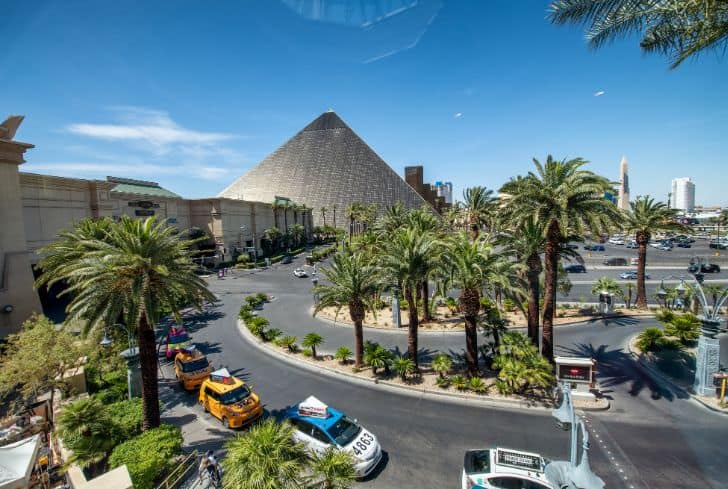
The Luxor Hotel Las Vegas is a massive hotel and casino complex located on the Las Vegas Strip in Nevada, USA. The hotel was built in 1993 and is named after the city of Luxor in Egypt. The hotel’s distinctive pyramid shape and Sphinx statue make it one of the most recognizable landmarks in Las Vegas.
The Luxor Hotel Las Vegas features over 4,400 rooms and suites, making it one of the largest hotels in the world. The hotel’s interior is designed to resemble an ancient Egyptian temple, with hieroglyphics and other Egyptian-themed decorations throughout the property.
The hotel’s main attraction is the Luxor Sky Beam, which is the strongest beam of light in the world. The beam is made up of 39 xenon lamps and can be seen from up to 275 miles away. The beam attracts visitors to the hotel and is often used as a backdrop for photos and videos.
The Luxor Hotel Las Vegas also features a large casino with over 120,000 square feet of gaming space. The casino offers various table games, slot machines, and other gaming options. The hotel also features several restaurants, bars, and lounges, as well as a spa, fitness center, and pool.
One of the most popular attractions at the Luxor Hotel Las Vegas is the Titanic: The Artifact Exhibition. The exhibition features artifacts recovered from the wreckage of the Titanic, as well as replicas of some of the ship’s most famous rooms.
17. Memphis Pyramid
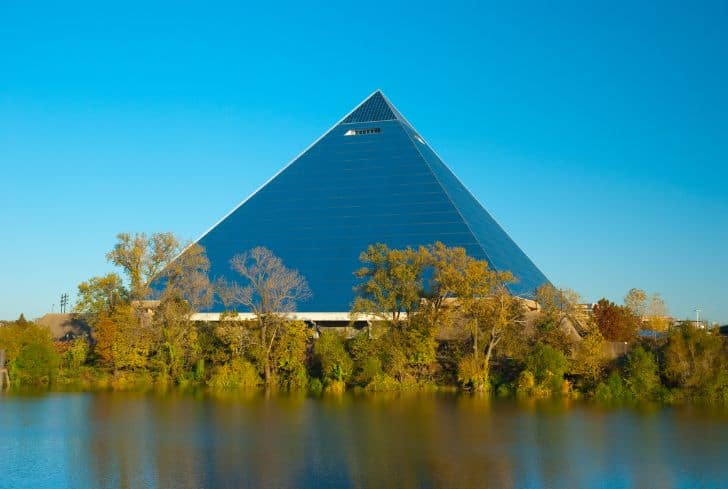
The Memphis Pyramid is a large pyramid-shaped arena located in Memphis, Tennessee, USA. It was originally built in 1991 as a sports and entertainment venue, and was the home of the Memphis Grizzlies basketball team until 2004.
The Memphis Pyramid stands over 320 feet tall and covers an area of over 360,000 square feet. It is one of the largest pyramids in the world, and its distinctive shape has made it a popular landmark in Memphis.
The interior of the pyramid features a large arena with seating for up to 20,000 people. The arena has hosted a variety of events over the years, including concerts, sporting events, and conventions.
In addition to the arena, the Memphis Pyramid also features a number of other attractions. There is a large retail space called the Bass Pro Shops at the Pyramid, which features a variety of outdoor gear and equipment. The space also includes a hotel, restaurants, and a bowling alley.
One of the most unique features of the Memphis Pyramid is its observation deck, which is located near the top of the pyramid. Visitors can take an elevator to the top of the pyramid and enjoy panoramic views of Memphis and the surrounding area.
18. Walter Pyramid
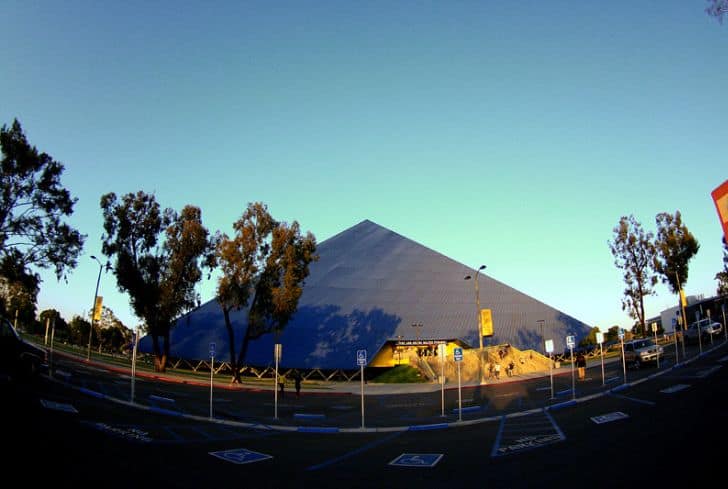
The Walter Pyramid is a unique sports arena located on the campus of California State University, Long Beach, in California, USA. It was built in 1994 and is named after Dr. Mike and Arline Walter, who donated $2.7 million towards its construction.
The Walter Pyramid is a 18-story structure that stands 120 feet tall and has a base measuring 345 feet by 345 feet. Its unique pyramid shape makes it a distinctive landmark in Long Beach. The pyramid is made of steel and concrete, and its exterior is covered in aluminum panels.
The interior of the Walter Pyramid features a large arena with seating for up to 5,000 people. The arena is used for a variety of sporting events, including basketball, volleyball, and gymnastics. The pyramid shape of the arena provides excellent sightlines for spectators, and the acoustics of the space are designed to enhance the sound of live events.
In addition to the arena, the Walter Pyramid also features a number of other amenities. There are locker rooms for athletes, as well as a weight room and training facilities. The pyramid also features a number of meeting rooms and event spaces that can be rented for conferences, banquets, and other events.
19. Transamerica Pyramid
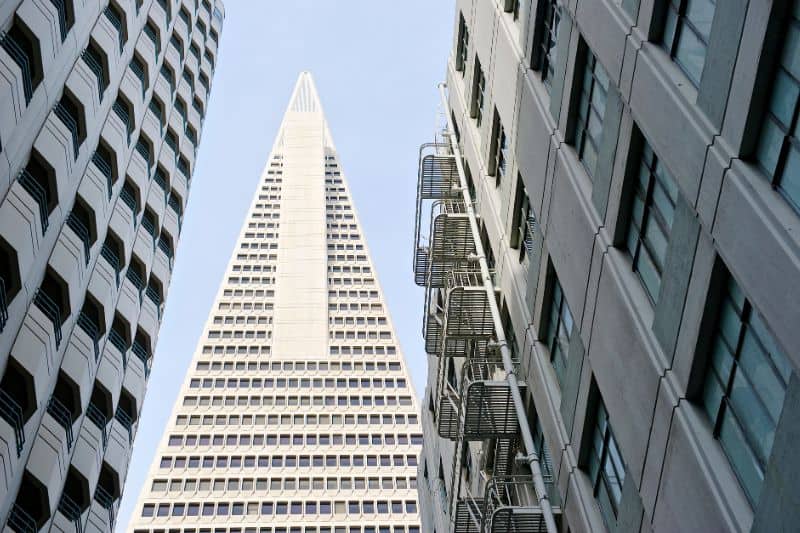
The Transamerica Pyramid is a San Francisco, California, USA skyscraper. It was completed in 1972 and stands 853 feet tall, making it one of the tallest buildings in San Francisco.
Architect William Pereira designed the Transamerica Pyramid and is a distinctive landmark in the city. Its unique shape, which tapers to a point at the top, was designed to maximize the amount of natural light that enters the building.
The exterior of the Transamerica Pyramid is covered in white quartz and aluminum panels, giving it a sleek and modern appearance. The building is also adorned with several decorative features, including a large redwood tree sculpture at its base.
The interior of the Transamerica Pyramid features a large atrium that rises 48 stories to the top of the building. The atrium is filled with natural light, thanks to the building’s unique design, and is home to a number of shops and restaurants.
The Transamerica Pyramid is primarily used as office space and is home to a number of businesses and corporations. The building’s location in the heart of San Francisco’s financial district has made it a popular destination for businesses looking to establish a presence there.
20. Ryugyong Hotel (North Korea)
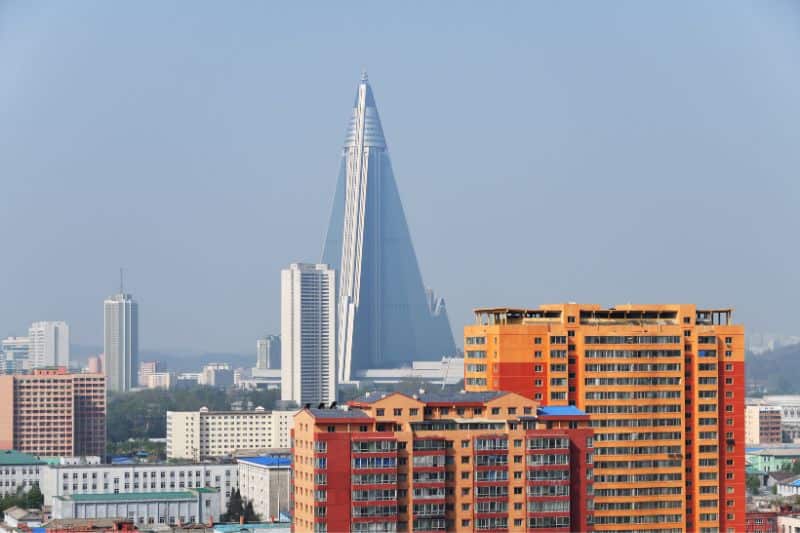
The Ryugyong Hotel is a massive skyscraper located in Pyongyang, North Korea. The hotel was first proposed in 1987 and construction began in 1989, but was halted in 1992 due to economic issues and political instability. Construction resumed in 2008 and the hotel was finally completed in 2011.
The Ryugyong Hotel is one of the tallest buildings in the world, standing at 1,083 feet tall with 105 floors. Its unique design, which features three wings that taper to a point at the top, has made it a distinctive landmark in Pyongyang.
The exterior of the Ryugyong Hotel is covered in mirrored glass panels, giving it a sleek and futuristic appearance. The building is illuminated at night, making it visible from miles away.
Today, the Ryugyong Hotel remains a prominent landmark in Pyongyang, and its distinctive design and towering presence continue to draw attention from around the world. However, its status as a functioning hotel remains unclear, and it is not currently open to the public.
21. Pyramid of Tirana
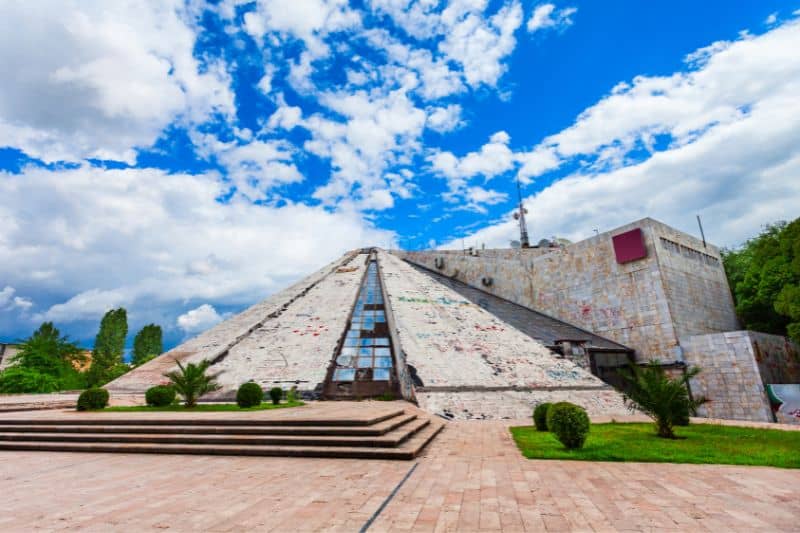
The Pyramid of Tirana is a unique pyramid-shaped structure located in Tirana, the capital city of Albania. It was completed in 1988 and was originally built as a museum to honor the country’s communist leader, Enver Hoxha.
The Pyramid of Tirana stands 106 feet tall and has a base measuring 92 feet by 82 feet. It is made of concrete and is covered in white marble panels. The pyramid shape of the structure is meant to symbolize the country’s past and future, and the ancient Mayan pyramids inspired its design.
After the fall of communism in Albania in 1991, the Pyramid of Tirana was repurposed as a conference center and later as a television studio. However, the building fell into disrepair over the years and became a source of controversy and debate over its future.
In recent years, there have been calls to demolish the Pyramid of Tirana and replace it with a new cultural center or public park. However, others have argued that the building should be preserved as a symbol of the country’s past and as a potential tourist attraction.
Overall, the Pyramid of Tirana is a unique and controversial structure that continues to draw attention and debate in Albania and worldwide. Its future remains uncertain, but its distinctive design and historical significance ensure that it will continue to be a prominent landmark in Tirana for years to come.
22. The Slovak Radio Building

The Slovak Radio Building is a unique and iconic structure located in Bratislava, the capital city of Slovakia. It was completed in 1983 and was designed by Slovak architect Štefan Svetko.
The Slovak Radio Building stands 262 feet tall and has a distinctive inverted pyramid shape. The building is made of concrete and is covered in aluminum panels, giving it a sleek and modern appearance.
The interior of the Slovak Radio Building features a large atrium that rises 11 stories to the top of the building. The atrium is filled with natural light, thanks to the building’s unique design, and is home to a number of offices and studios.
The Slovak Radio Building is primarily used as the headquarters for Slovak Radio, the national public radio broadcaster in Slovakia. The building is home to a number of radio studios and offices, as well as a concert hall and a museum.
The building has become a popular tourist attraction in Bratislava, thanks to its unique design and cultural significance. It is considered one of Slovakia’s most important examples of modernist architecture and has been recognized as a national cultural monument.
23. Summum Pyramid

The Summum Pyramid is a unique and unusual structure located in Salt Lake City, Utah, USA. It was built in 1975 by a religious group called Summum, which was founded by Claude “Corky” Nowell.
The Summum Pyramid stands 3 stories tall and is made of concrete. Its exterior is covered in gold leaf, giving it a distinctive and eye-catching appearance. The pyramid is surrounded by a small park and a fountain, and is located near the foothills of the Wasatch Mountains.
The interior of the Summum Pyramid features a large meditation chamber, which members of the Summum group use for spiritual practices and ceremonies. The chamber is decorated with Egyptian-inspired artwork and symbols, and is said to have a calming and peaceful atmosphere.
The Summum Pyramid is also home to a mummification facility, where members of the Summum group can have their bodies mummified after death. The mummification process is said to be based on ancient Egyptian techniques, and is considered a central part of the group’s spiritual beliefs.
24. Palace of Peace and Reconciliation (Kazakhstan)
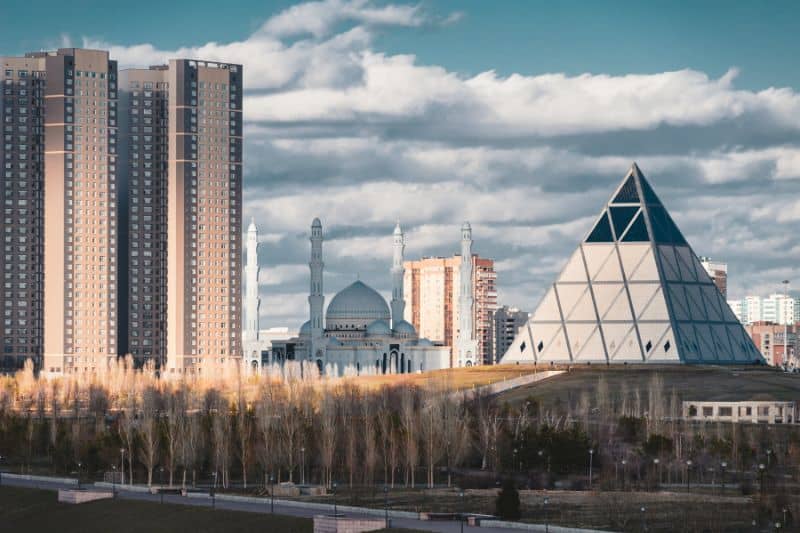
The Palace of Peace and Reconciliation is a unique and striking structure located in Astana, the capital city of Kazakhstan. It was completed in 2006 and was designed by British architect Norman Foster.
The Palace of Peace and Reconciliation stands 203 feet tall and has a distinctive pyramid shape. The building is made of glass and steel, and is covered in a pattern of triangles that represent the diversity of Kazakhstan’s population.
The Palace of Peace and Reconciliation interior features a large atrium that rises to the top of the building. The atrium is filled with natural light, thanks to the building’s unique design, and is home to a number of event spaces and meeting rooms.
The Palace of Peace and Reconciliation is primarily used as a venue for conferences, meetings, and cultural events. The building is home to a number of permanent art installations, including a stained glass window that depicts the sun and the moon and a large mural that represents the unity of the world’s religions.
25. Hanoi Museum

The Hanoi Museum is a modern and striking museum located in Hanoi, the capital city of Vietnam. It was completed in 2010 and was designed by German architect, von Gerkan, Marg and Partners.
The Hanoi Museum is an impressive structure that stands out for its unique design. The museum is shaped like a stylized inverted lotus flower, symbolizing purity and enlightenment in Vietnamese culture. The building is made of concrete and is covered in a layer of ceramic tiles that give it a shimmering appearance.
The interior of the Hanoi Museum features a number of exhibit halls that showcase the history and culture of Hanoi and Vietnam. The museum’s collection includes a wide range of artifacts, including ancient pottery, traditional costumes, and historical documents.
One of the most impressive features of the Hanoi Museum is its large central atrium, which rises to the top of the building. Thanks to the building’s unique design, the atrium is filled with natural light and is home to several interactive exhibits and multimedia displays.
Conclusion
In this article, we have looked at some of the famous examples of pyramids. Given their stable structures, pyramids existed all across the globe: from Egypt to Indonesia. They used to be the tallest man-made structures once, and today, they continue to fascinate people with their grandness.






